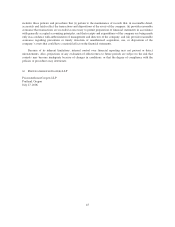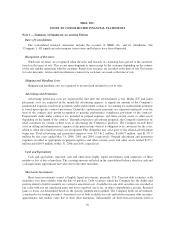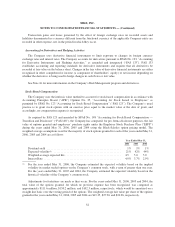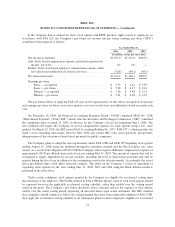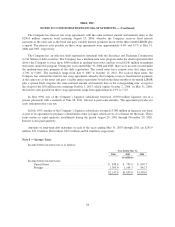Nike 2006 Annual Report Download - page 55
Download and view the complete annual report
Please find page 55 of the 2006 Nike annual report below. You can navigate through the pages in the report by either clicking on the pages listed below, or by using the keyword search tool below to find specific information within the annual report.NIKE, INC.
NOTES TO CONSOLIDATED FINANCIAL STATEMENTS — (Continued)
vesting upon retirement. Had the Company been accounting for such stock options using the accelerated vesting
schedule for those employees eligible for accelerated vesting upon retirement, the Company would have
recognized additional stock-based compensation expense in the above pro forma of $0.01 per diluted share in the
year ended May 31, 2006 and $0.05 per diluted share for the years ended May 31, 2005 and 2004. The Company
usually grants the majority of stock options in a single grant in the first three months of each fiscal year. As a
result, accelerated vesting will normally result in higher expense in the first three months and lower expense in
the last nine months of each fiscal year, as compared to the pro forma expense disclosed by the Company under
our current policy of expensing such options ratably over the stated vesting period.
Income Taxes
The Company accounts for income taxes using the asset and liability method. This approach requires the
recognition of deferred tax assets and liabilities for the expected future tax consequences of temporary
differences between the carrying amounts and the tax basis of other assets and liabilities. United States income
taxes are provided currently on financial statement earnings of non-U.S. subsidiaries that are expected to be
repatriated. The Company determines annually the amount of undistributed non-U.S. earnings to invest
indefinitely in its non-U.S. operations. See Note 8 for further discussion.
Earnings Per Share
Basic earnings per common share is calculated by dividing net income by the weighted average number of
common shares outstanding during the year. Diluted earnings per common share is calculated by adjusting
weighted average outstanding shares, assuming conversion of all potentially dilutive stock options and awards.
See Note 11 for further discussion.
Management Estimates
The preparation of financial statements in conformity with generally accepted accounting principles requires
management to make estimates, including estimates relating to assumptions that affect the reported amounts of
assets and liabilities and disclosure of contingent assets and liabilities at the date of financial statements and the
reported amounts of revenues and expenses during the reporting period. Actual results could differ from these
estimates.
Reclassifications
Certain prior year amounts have been reclassified to conform to fiscal year 2006 presentation. These
changes had no impact on previously reported results of operations or shareholders’ equity.
Recently Issued Accounting Standards
In November 2004, the FASB issued SFAS No. 151, “Inventory Costs, an amendment of ARB No. 43,
Chapter 4” (“FAS 151”). FAS 151 clarifies that abnormal inventory costs such as costs of idle facilities, excess
freight and handling costs, and wasted materials (spoilage) are required to be recognized as current period
charges. The provisions of FAS 151 are effective for the fiscal year beginning June 1, 2006. The Company has
evaluated the provisions of FAS 151 and does not expect that the adoption will have a material impact on the
Company’s consolidated financial position or results of operations.
In December 2004, the FASB issued FAS 123R. In March 2005, the SEC issued SAB 107 regarding the
SEC Staff’s interpretation of FAS 123R. See the Stock-Based Compensation section within Note 1 above for
further discussion.
54



